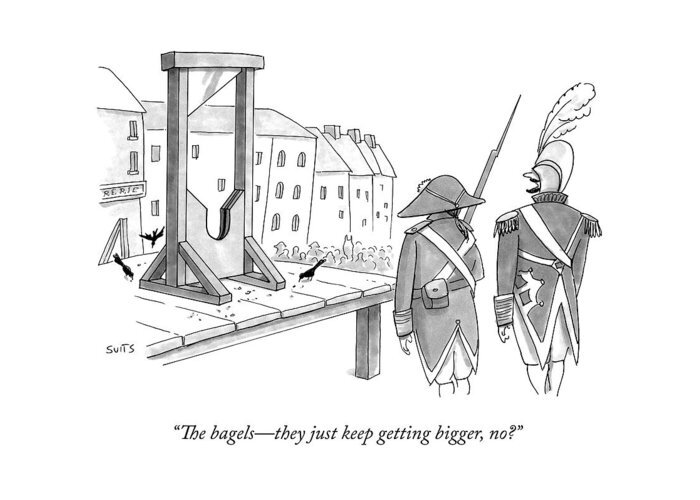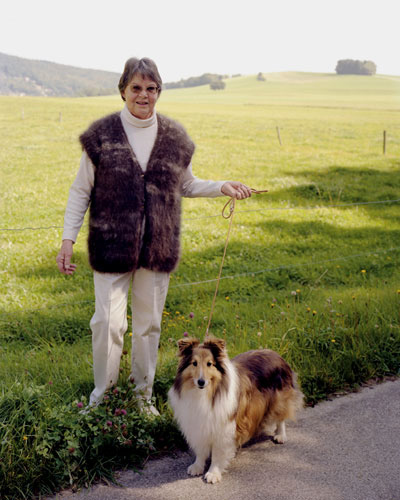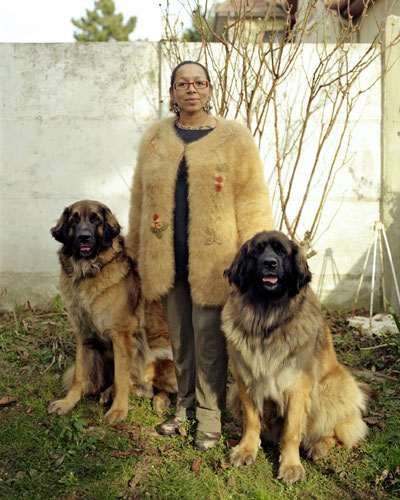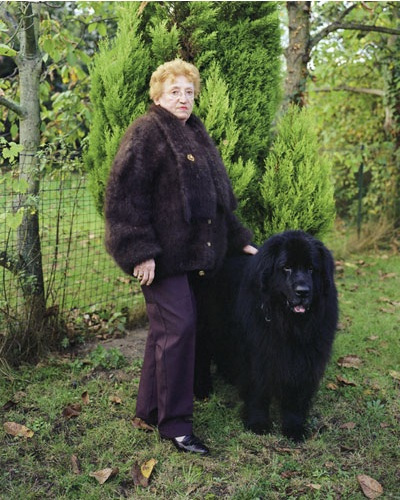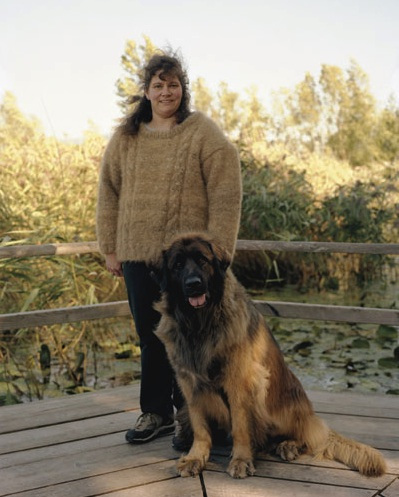
The Guillotine: A Revolutionary Blade
The story behind the infamous chopping block.
by Brian Alcamo
This week, France celebrates le Quatorze Juillet. In the United States, we know this day as Bastille Day. While the actual storming of the Bastille happened two years after the start of the French Revolution, it is one of the movement’s defining moments as it kicked off an era of violence and upheaval that inevitably overturned the French monarchy. The violence and havoc typical of the French Revolution was defined and symbolized by one special device: la guillotine.
Let’s Explore This Hauntingly Iconic Instrument Of Revolution!
If you think capitation by guillotine sounds gruesome, you should know that things used to be much worse. In pre-guillotine 1700s France, people were executed by having their four limbs stretched (and eventually ripped) apart by four oxen that would each run out from the executé’s body. Members of the upper-class could upgrade their execution to a less painful hanging or beheading. Luckily, people eventually caught on to the idea that this style of execution was perhaps a bit much, and in 1789, French physician Doctor Joseph Ignace Guillotin pushed for the invention of a new machine that would behead criminals “painlessly” (yeah, right). Not only did the doctor wish to make persecution less painful, he also wished to make it equal amongst the social classes. The doctor wished for the end of the death penalty entirely, and believed that a standard beheading device done in private could bridge the gap between the rather theatrical and brutal public dismembering and the eventual end of capital punishment.
Despite Doctor Guillotin’s supposedly revolutionary dream of an equal-opportunity beheader, other European countries had already beaten him to the punch (or, chop). In Scotland, a predecessor of the guillotine, known as the Maiden, was in use. but France’s guillotine was the first to be used at the institutional level. Doctor Guillotin worked with German engineer (and harpsichord maker) Thomas Schmidt to build the first guillotine, opting for a diagonal blade as opposed to a round one.
The invention of the guillotine came just in time for the French Revolution. After the storming of the Bastille on July 14th, 1789 (the Revolution’s peak), a new civilian code crafted by the National Assembly was put into place, that equalized the death penalty among France’s social classes. While this isn’t the ideal way for a campaign of equality to start out, it did make the earthly gateway to the Great Equalizer a bit more egalitarian. The first guillotining took place at Place de Greve in Paris on April 25th, 1792 when Nicolas Jacques Pelletier, a highway robber, got the inaugural chop. This kicked off the Reign of Terror, or la Terreur, which was a period of time in which thousands of people were sentenced to death. Despite only lasting about two years, this era is usually what people imagine when they think of the French Revolution. Many notable aristocrats died during this time, with King Louis XVI suffering a blow by the merciless blade on January 21, 1793.
Credit: Julia Suits
Some Revolutionary Vocab for Your French Flashcards:
Un citoyen - a citizen
La monarchie - The monarchy
Un.e paysan.nne - a peasant
Imposition - taxation
La peine capitale - Capital punishment/the death penalty
After the Revolution
After the Revolution, the guillotine remained as France’s capital punishment method of choice. Other European countries such as Greece, Sweden, and Switzerland also continued to use the guillotine, although the device never made much of a splash in the Western Hemisphere. Parisian guillotine sites moved around a bit before ending up in Grand Roquette prison in 1851. In 1870, a man named Leon Berger brought much-needed changes to the machine’s design, adding a spring system, a locking device, and a new release mechanism for the blade. These redesigns set the standard for all new guillotines moving forward.
This was the period of time where a study known as Prunier’s Experiment took place. Researchers had been trying to figure out if the head maintained some level of consciousness after decapitation. Scientists obtained the consent of Monsieur Theotime Prunier in 1879, a death-row sentence, and poked and prodded his head after he was struck by the guillotine. All they could note was that the face maintained an expression of astonishment after the death, but it did not respond to any stimuli.
By 1909, the guillotine was being used behind La Santé Prison. The final execution by guillotine was on September 10th, 1977 in Marseille when murderer Hamida Djandoubi was put to death. While he was the last execution in France, he was not the last to be condemned to execution, with those condemned afterwards being exhumed after the election of François Mitterand in 1981.
The guillotine’s roughly two centuries of notoriety may have come to a close, but its memory lives on as a symbol of what can happen when a thirst for wide-scale violence supersedes enlightened revolutionary thought.
Thanks for Reading!
How do you feel about the French Revolution? Tell us in the comments below, and make sure you share this post with a fellow French-fanatic!
French People and Their Obsession With Cheese
How can something that smells so bad taste so good?
There are more than a 1000 sorts of cheese in France alone and it represents centuries of pure French traditions! No wonder the French use the expression "en faire tout un fromage" (to make a cheese out of it) to refer to someone who blows things out of proportion! In this post, we are presenting you with 5 of our favorite French cheeses. Learn how they came to existence and how you can cut and eat them. Enjoy this post and remember to "let them eat cheese!"
1. Le Fromage de Roquefort
Credit: Cyn Furey
Ah, le Roquefort! Easily recognizable by its blue-greenish dots in a white body, this cheese is part of the blue cheese family. Roquefort is a town located in the Landes, in the southwest of France. It dates back to the 12th Century when people already used the Caves of Roquefort to salt and affine their cheeses. The legend says that a shepherd left his cheese sandwich in a cave in Roquefort to court a young and beautiful woman. After chasing her with no results, he came back and found his sandwich with blue dots in it. Roquefort was born. Wether you believe in the legend or not, Roquefort cheese is now an AOC & AOP cheese, meaning that if the cheese is not made in the caves of Roquefort, then you cannot call it Roquefort. It is the champagne of the cheeses!
How to eat it?
You can eat Roquefort cold in a gaspacho or on a tartine with a touch of butter. Or, you can eat it warm as a mushroom stuffing.
How to cut it ?
Roquefort is part of the blue cheeses and need to be cut in quarters.
2. Le comté
Comté cheese dates back to the 13th Century. It is derived from the Gruyère cheese that was introduced at the end of the 13th Century. Comté is a cheese made from cow milk and is from the region of Franche-Comté. During the Middle-Ages, winters were long and hard. People had to think collectively how to get through the rough winters. It forced farmers to work together to better use the provisions that they could get over the summer. Indeed, cows were producing a lot of milk over the summer and then less during the winter. People would therefore make huge wheels of cheese that would require over a 130 gallons of milk (500L) to produce. Farmers had to work collectively to bring together those huge amounts of milk so they organized as "cooperatives". Comté is a symbole of farmers working together so they could survive the winter.
How to eat it?
Comté can be enjoyed cold with a piece of bread or warm in any dish you like. It is preferred with chicken and beef or even with cod fish.
How to cut it?
Because Comté comes out of a huge wheel, the slices of comté you will get will be long. You must cut the heart of the wheel in long slices and then you have to cut the rest from the center to the crust.
3. Le mont D'or
Photo Credit: Arnaud 25
Mont D'or is probable everything you can imagine about cheese. Warm, melty, lovely cheese that you add to a meal to make it as decadent as possible! The most ancient form of this cheese dates back to 1280. Unlike Comté, it does not require a lot of milk to make because it is mostly made during the winter. Mont D'or only needs less than 2 gallons of milk to be produced. This is why it is a soft, rich and seasonal cheese from Franche-Comté as well! Because of its consistency, the cheese is encircled with a "belt" made out of a specific wood, usually spruce.
How to eat it?
Mont D'or can be easily spread on bread or you can take it up a notch and the cheese becomes your own portable fondue! Just warm up the cheese case (made our of spruce, of course) and then remove the top crust and dip! It becomes a "boîte chaude"
How to cut it?
Because of its consistency, it is hard to "cut" this cheese. It is recommended to remove the top crust and serve it with a spoon.
4. Camembert
Photo Credit: NJGJ
Camembert is probably the most popular cheese in modern France. It was created in the 18th Century in the Town of Camembert in the northeast of France. According to Pierre Androuët, this mix between curd cheese and brie became popular after Parisian tourists brought it back to Paris for people to enjoy in the 18th Century. Camembert was so good that it became part of the food rations for soldiers during the First World War, helping growing its popularity. Not only is the cheese popular but the box in which it is kept also is! People who collect Camembert's boxes are called Tyrosémiophiles. Along with la baguette, Camembert is a symbole of France.
How to eat it?
Simply on a baguette et voilà!
How to cut it?
Just like a cake, in equal parts from the center to the ridge.
5. Beaufort
Photo Credit: Coyau
Le Beaufort is a very old cheese that is produced in the region of Savoie, in Beaufort to be exact. History shows that this cheese was made before the Middle-Ages and continue to be produced today. It is only in 1965 that the cheese produced in the Beaufort region is called Beaufort. This cheese is firm, yellow, and concave. It is an essential ingredient for a Fondue Savoyarde! Cheese fondue is something that everyone loves! Picture a winter night, cold weather outside and a warm pot of cheese in which you dip pieces of bread for you to enjoy... MiamMiam !
How to eat it?
In slices with crackers or in a warm fondue pot mixed with other cheeses such as Gruyère de Savoie, Emmental de Savoie, white wine and pepper!
How to cut it?
Cut it in very thing quarters.
We hope you enjoyed this delicious array of cheeses in French People and Their Obsession With Cheese! We hope you spend a wonderful (French-inspired) fall with your guests. If you are looking to learn more French language and culture, don't forget to check out our French Private Lessons, French Group Classes, and our cultural events at JP Linguistics. Bonne Journée!
Are The French Religious?
There’s more than meets the eye to the country and its strict separation of church and state.
Religion is often a huge topic of conversation around the world (even among Atheists). Many people prefer to keep such topics to a minimum, but when learning how to speak French it's important to know cultural norms which includes religion. Which religions are popular? Are most people in France Catholic? Jewish? Muslim? Where are the most popular mosques, cathedrals, and synagogues to visit? Is there a large percentage of atheists in France? Have no fear, we are here to shed some light on the subject with Are The French Religious? We hope you enjoy!
It may come as no shock that the majority of religious people in France consider themselves to be Christian (45% of the population). A tourist visiting France for the first time would quickly come to this realization through evidence in the many cathedrals that grace the landscape across the county. However, many French citizens in modern society are not big on practicing any particular religion and have a difficult time identifying what religious group they belong to. This confusion stems from the tradition of being baptized at birth in a Catholic Church, but not practicing Catholic traditions beyond that. If you were to ask a French person today what religion they are, a common response might be 'Christian, but my family never goes to church.' In fact, a solid number of those (who were baptized at birth) might consider themselves today to be Atheist or Agnostic. To understand the demographics of religions in France, one major consideration comes to the surface. Due to a law from 1872, any performed census in the French Republic is not allowed to distinguish citizens based on their race or beliefs. However, that law does not pertain to polls and surveys (which are free to included those questions if they wish). That said, we rely on 'polls' and 'surveys' to collect the data about religious demographics. IPSOS Mori (one of the largest research companies in the world), conducted a survey from 2011 which helps us better understand some of the religions groupings in France.
If we look at the numbers - 45% of French people consider themselves to be Christians (almost all Roman Catholic), 35% consider themselves Atheist or Agnostic, 3% Muslim, 1% Buddhist, 1% Jewish, 5% adhere to unspecified other religions, and 10% did not give an answer to the question. This means that Catholicism still hails as the most popular religion in France. However, according to a 2009 study from the French Institute of Public Opinion (IFOP), only 4.5% of self-declared Catholics go to church each week. This shows that France, in general, does not have a huge number of practicing religious members who attend religious ceremonies on a weekly basis.
One possible conclusion regarding the lack of attendance in the religious settings might be based on the French principal of Laïcité (the absence of religion in political affairs - especially regarding the creation of government policies). The country as a whole welcomes religious freedom and, since the 1789 Revolution (which broke the Roman Catholic church away as a claimed 'state religion'), the French culture hasn't been infusing religion into its weekly traditions as much. Overall, in modern French culture religion isn't a major focus and the country is considered to be one of the more secular ones in the world.
Regardless of the numbers, religious structures can be seen all over France. Check out a few of my favorites below.
Grande Synagogue de la Victoire - Image: Ed Alcock for the New York Times
Located in Paris, this building began construction in 1867 and contains a wonderful number of details including a series of 12 stained glass windows representing the Tribes of Israel.
Synagogue Notre Dame de Nazareth - Image: capteurdmotion.com
Located in Paris, this building is the oldest of the 'great' synagogues of Paris.
Saint Etienne Cathedral - Image: commons.wikimedia.org
Located in Bourges, France, this Roman Catholic cathedral was built to honor Saint Stephen.
Cathedral Notre-Dame, Rouen - Image: theluxurytravelexpert.com
Located in Rouen, the gothic style cathedral was destroyed during a Vikings invasion in 841. After continuous rebuilding and updating, its 19th century cast iron spire is that tallest in France.
Grand Mosquée de Paris - Image: huffingtonpost.fr
Located in the center of Paris, visitors are welcome to visit (not allowed in the practice area) and can eat at the connected arab restaurant.
Grande Mosquée de Lyon - Image: lyon-france.com
France's sixth largest mosque, which houses cultural facilities, a library, and a school.
Saint Pierre aux Nonnains Basilica - Image: aladecouvertedenotrepatrimoine.blogspot.com
One of the oldest churches in all of Europe, this basilica in Metz, France was originally built as a Roman gymnasium in 380 AD, then converted to a church in the 7th Century. It later became a warehouse and, in 1970, was transformed into a concert hall and exhibition space.
To answer the question Are The French Religious? Yes. Overall, the majority of citizens believe in some form of higher power, but choose not to practice through an organized religion on a consistent or weekly basis. Many holidays and traditions continue to be based on religious calendars such as Fête de Noël (Christmas) and Fête de Hanoucca (Chanukah). These celebrations make for great visits to France which often include festivals, gatherings, and plenty of cultural food and drink.
I hope you enjoyed this post! To learn more about French language and culture, visit www.jplinguistics.com and sign up for one our French Group Classes or Private Lessons. Also, don't forget to tell your francophone friends about our blog by using #jplingo @jplinguistics.
(Source information from above: wikipedia.org 'Religion in France')
A Unique Spin on French Fashion for Dog Owners
Dog clothes made from your dog’s favorite fabric: their own fur!
With New York being one of the fashion capitals of the world, I thought I would shed some light, quite literally, on a France-based textile company that is putting a very Unique Spin on French Fashion for Dog Owners. As strange as this may sound, the company collects old dog fur and weaves it into yarn so that dog owners can knit their own sweaters using it. We must admit, our heads turned after finding news of this company, but it wasn't until we saw images from French photographer, Erwan Fichou, that the concept made slightly more sense. For all you fashionistas out there, this is one fashion trend you don't see everyday! Keep scrolling to see a collection of images called DogWool by Erwan Fichou. Whouff! Whouff!
For more information about 'Dogwool,' the French company making these yarns, visit their website. Would you ever wear your dog's fur? Post your response down below and share this with your friends. Looking to learn French? Visit JP Linguistics for the latest Group Classes, Private Lessons, and Cultural Events.
Why The French Don't Get Fat
Diving into the secrets of a long-held, kind-of-true stereotype.
For the French, playing outside and eating healthy is part of their cultural blood to maintain a healthy diet and enjoy nutritious foods. It's imperative to know that French people sincerely enjoy food and nutrition. It's seen as a pleasure, not a chore. That's why I'd like to shed some light on Why The French Don't Get Fat. Of course, we're being very general here as we cannot speak for ALL French people, but we can invite you into a few secrets of how the French stay so skinny. Sit back, get cozy, and enjoy the read. Who knows, it might just inspire a few new healthy habits just in time for fall?
Some of you might be thinking how unfair it is to travel around France only to be surrounded by slender, form-fitted fashionistas divulging in butter-soaked croissants and delicious whipped cream patisseries... none of them seeming to gain an inch of fat during the aftermath. In order to understand this 'phenomenon,' it makes most sense to start at the very beginning, to dive into what French children are taught at very young ages about food. Let's consider the school cafeteria as our starting grounds.
School lunches in French are often considered a pedagogical tool in which kids are fed a wide variety of dishes, fruits, vegetables - all monitored by the strict Ministry of National Education which ensures that fried foods are not served more than once per month, for example. Kids are taught to only drink water during their lunch and to use condiments, such as ketchup, only with dishes that require it. Vending machines are banned from schools which mean that soda pop and processed foods are not over consumed. Sweet treats, such as a chocolate mousse, are only served once per week in the cafeteria which teaches kids that a treat is a treat. French adults, parents and teachers believe that a child can be taught how to eat properly, just like learning to read. Thus, it is considered one of the most important skills to develop during childhood.
In addition to having strict policies regarding food consumption for kids, cultural etiquette plays a big role into food schedules for kids. Parents are expected to teach their children to eat only 3 times per day, with 1 additional snack permitted under a strict schedule each day (called 'the goûter'). Portion sizes are much smaller than the U.S. and children typically eat the same foods as the adults (complaining is prohibited). This includes eating items like radishes, grated carrot salad, endives, plenty of fish, and stinky cheeses. For the 'picky eaters,' research shows that in order for a child to accept eating something new, it must be tasted at least 7 times. Further tasting is necessary in order for a child to learn to like the food item. As this knowledge has quietly weaved itself into the French culture, parents and school teachers take the necessary steps to teach kids to love healthy foods. Instead of forcing a kid to eat something healthy, they simply incorporate the food item into meals 7 times + at a young age. This has proven to help kids learn to love healthy foods.
As children grow older, these instinctual habits help to form a respect and understanding for food. This is why French culture allows for food to be consumed under a 'pleasure principle,' meaning that food is seen as something to celebrate and enjoy rather than something to feel anxious about. A study done by Paul Rozin (a University of Pennsylvania Psychologist) and Claude Fischler (a French sociologist) surveyed 4 countries - France, Japan, Belgium, and the U.S. In the survey, they found that the U.S. associates food with 'health,' not 'pleasure,' and worries the most about food choices in comparison to the other countries in the study. When shown a picture of heavy cream, for example, the Americans associated it with the word 'unhealthy,' whereas the French associated it with the word 'whipped.' When shown a picture of a chocolate cake, Americans most frequently responded with 'unhealthy' and 'calories,' whereas the French associate it with the terms 'celebration' and 'pleasure.' The idea here is that focusing on the joy that food brings, French people are able to appreciate the foods they eat and savor them as something pleasureful.
Food education starts at a very young age in France and thus it the common thread for Why The French Don't Get Fat. There is a great book that you can read called 'French Kids Eat Everything' by Karen Le Billon, who inspired this article. Check it out and continue to read more about ways the French are a good example of great eating habits.
If you would like to learn more about French culture or how to speak French, don't forget to check out our Private Lessons & Group Classes taught by native instructors at www.jplinguistics.com. Also, we'd love to hear your thoughts on this subject, so leave a comment below and share this link with others using #jplingo @jplinguistics. Merci!
Funny French Idioms
Impress native speakers with your knowledge of these fun French idiomatic phrases.
If you speak French (or are learning), you'll know that some expressions used in the language can be quite humorous when translated verbatim from French to English. That's why we wanted to brighten your day with Funny French Idioms, phrases the French use which can translate unexpectedly. Next time you find yourself in these real life scenarios, try using French idioms to stir the conversation!
1. It's not all about size... or is it? Perhaps you are a person who is shorter than most people your age, or maybe you know someone who is. Often, this height difference might stir a few jokes from a friend who might say to you 'Vous êtes haut comme trois pommes.' This statement is a clear indication that someone may be making fun of your size. In French, this phrase is a way of saying 'You are vertically challenged.' However, this isn't exactly the literally translation. The common phrase 'Être haut comme trois pommes' actually equates to 'To be tall like 3 apples' (which is pretty small). So, the next time you interact with a 'vertically challenged' person try incorporating this clever phrase! It's a head turner.
2. If you have a knack for recognizing natural French accents, this idiom is for you. There are instances where a non-native speaker will try to converse in French as naturally as possible, but feel shy and pause mid-sentence to say 'pardonnez mon accent, mais...' (excuse my accent, but...). If speaking to a French native, the listener might respond with a little sarcasm and say 'Non, non, vous parlez parfaitement le français. Est-ce que vous êtes français?” (No, no, you speak perfect French. Are you French?). A clever non-native speaker in this scenario might think to themselves 'he/she must be pulling my leg' in which the following phrase would be appropriate - 'Vous vous payez ma poire?' (the common French idiom meaning 'Are you pulling my leg?'). Technically though, this phrase translates to 'Are you buying yourself my pear?' which could be confusing to non-native speakers, yes, but to the French it makes perfect sense! In any case, next time someone is being sarcastic with you, try using this phrase to see if they are 'buying your pear!'
3. Keeping in theme with pears, there is another idiom the French love to use whenever someone is having a really good time. The phrase is 'se fendre la poire' and technically translates as 'to split the pear' but means 'to split one's sides' (or to laugh extremely hard or have a really good time). If you are out somewhere with hilarious French-speaking friends and are really enjoying yourself, slip in the phrase 'On se fend la poire là, non?' (We're having a ball, aren't we?).
These simple, funny French idioms are often used among friends and are a great way to practice your French. Do you know any French idioms? Make sure to post them in the comments section below and help continue the conversation. Also, you can post them on our Twitter using #jplingo @jplinguistics!



